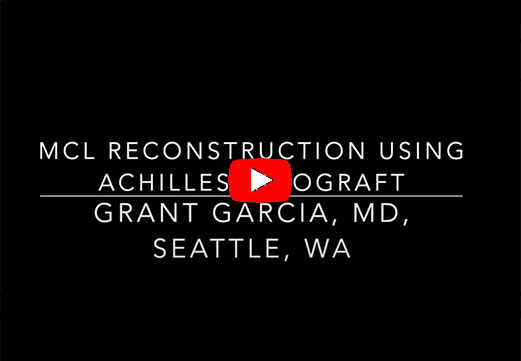MCL Repair and Reconstruction
Dr. Garcia discusses the cutting-edge technology “internal bracing” in his latest podcast and how it’s getting top athletes back faster.
MCL and DK Metcalf IRG Kiro Segment
The medial collateral ligament (MCL) is one of the main ligaments in the knee and travels from the femur (thigh bone) to the top of the tibia (shin bone) and resides on the internal part of the knee joint. MCL injuries account for approximately 24 percent of all knee injuries and lead to pain, swelling and knee instability. The MCL is critical to knee stability so when it sustains a tear during a sports injury or during a fall, patients can experience a variety of troublesome symptoms. Unlike the ACL, the MCL is able to heal on its own after injury, however, some tears may be so severe that they require surgery to repair or reconstruct the torn MCL. Dr. Grant Garcia, specializes in a number of knee treatments, including management of MCL injuries and MCL reconstruction.
Check out Dr. Garcia’s technique for MCL reconstruction.
An MCL injury is generally seen during sports activities when there is contact to the outside of the knee or excessive rotation of the joint. The ligament may be injured in isolation or part of a multi-ligament knee injury. In the majority of cases, an MCL tear can heal on its own with non-operative treatment. In cases where a complete tear with instability is present, an MCL surgery may be recommended to restore stability and function to the knee joint.
Updated MCL reconstruction with internal brace
Before performing an MCL reconstruction, Dr. Garcia will perform a thorough physical examination of the joint and will examine X-rays and an MRI to determine the extent, location and pattern of the ligament injury. In most cases, a conservative approach is undertaken including bracing, short term use of crutches, and physical therapy to gradually regain motion, strength and function. Patients with low grade injuries can often return to sports activities within two weeks, while those with higher grade injuries may require eight to twelve weeks for full recovery.
If surgery is necessary, he will discuss the torn MCL surgery, either MCL augmentation or MCL reconstruction, in detail with the patient. An augmentation procedure involves repairing the torn ligament with sutures and at times using one of the patient’s hamstring tendons to reinforce the repair. An MCL reconstruction is reserved for patients with a severe or long-standing ligament tear. A reconstruction procedure utilizes either a donor graft or a hamstring graft harvested from the patient. During this MCL surgery technique, the graft is placed in the exact location to replace the torn ligament with new tissue. The graft is then secured with anchors and/or screws placed into the bone that contain strong sutures. Both torn MCL surgery techniques are highly effective at repairing the damaged area and restoring knee stability.



















